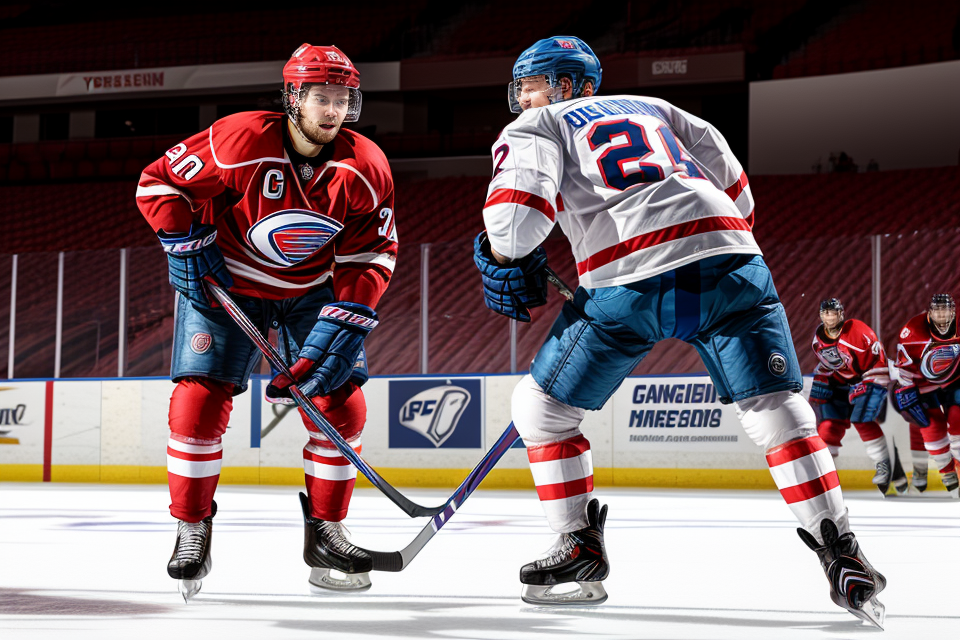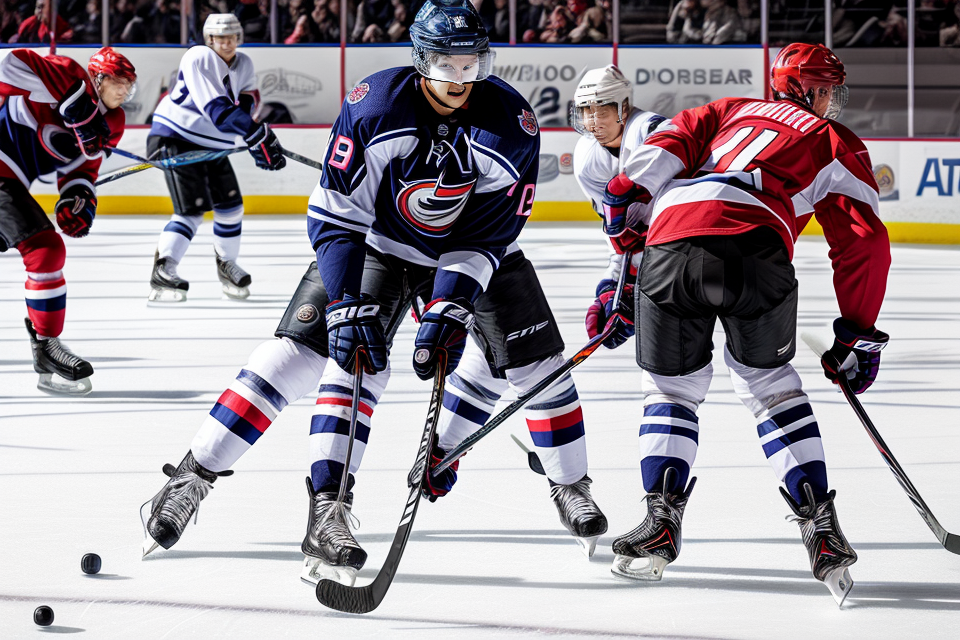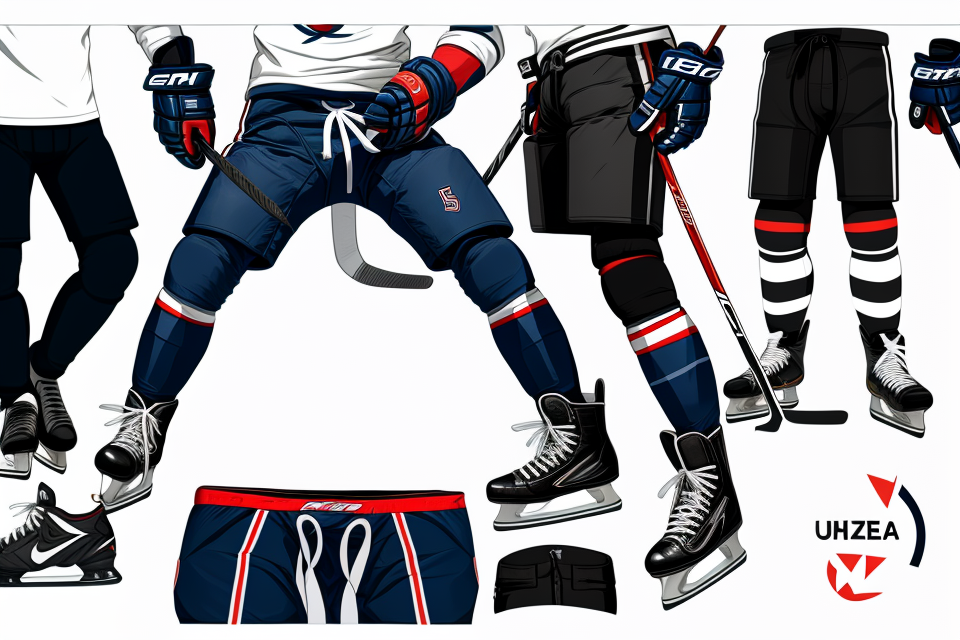Hockey is a fast-paced and physically demanding sport that requires players to wear specialized gear to protect themselves on the ice. One crucial piece of equipment is the hockey pants, which provide essential padding and support for the thighs, hips, and knees. However, with so many sizes and styles available, it can be challenging to know which pair of hockey pants to buy for your child. In this article, we will guide you through the process of measuring your child for the perfect fit in hockey pants, ensuring they have the right gear to perform at their best on the ice.
Understanding the Importance of Proper Sizing
Factors Affecting Hockey Pant Fit
Properly fitting hockey pants are crucial for optimal performance and comfort during games and practices. There are several factors that can affect the fit of hockey pants, including body proportions, skating style, and equipment compatibility.
- Body Proportions: A player’s body proportions play a significant role in determining the proper fit of their hockey pants. The size and shape of a player’s hips, thighs, and calves can impact how their pants fit around the waist, thighs, and calves. Additionally, the length of a player’s torso and arms can affect the fit of the pants’ arms and hemline.
- Skating Style: A player’s skating style can also impact the fit of their hockey pants. For example, players who prefer a more aggressive skating style may require pants that are more form-fitting around the thighs to allow for greater mobility. On the other hand, players who prefer a more relaxed skating style may prefer looser-fitting pants that provide more comfort and range of motion.
- Equipment Compatibility: Finally, the fit of a player’s hockey pants can also be affected by the compatibility of their equipment. For example, if a player wears a specific brand of skates or shin pads, they may require hockey pants that are designed to work with those specific pieces of equipment. In addition, some players may prefer pants with certain features, such as extra padding or ventilation, which can also impact the fit and comfort of the pants.
It is important to consider all of these factors when measuring a child for hockey pants to ensure the perfect fit and optimal performance on the ice.
Consequences of Improper Sizing
Improperly sized hockey pants can have a significant impact on a child’s performance and safety on the ice. Some of the consequences of wearing hockey pants that are too small or too large include:
- Discomfort: Hockey pants that are too tight or too loose can cause discomfort for your child, which can be distracting and affect their focus on the game. This discomfort can also lead to a decrease in performance, as your child may not be able to move as well as they need to.
- Limited mobility: Hockey pants that are too tight can restrict your child’s movement, making it difficult for them to skate, turn, and move in the way they need to on the ice. This can affect their ability to perform at their best and can increase their risk of injury.
- Increased risk of injury: Hockey pants that are too loose can cause your child to trip and fall, as they may catch on their skates or get caught in their equipment. This can lead to injuries such as sprains, strains, and even concussions. Additionally, hockey pants that are too loose can cause your child to lose their balance, which can also increase their risk of injury.
Measuring Your Child for the Perfect Fit
Gathering the Necessary Tools
To accurately measure your child for the perfect fit in hockey pants, you will need to gather a few essential tools. These tools will help you take precise measurements and ensure that the hockey pants fit your child correctly. Here are the necessary tools you will need:
- Tape measure: A tape measure is a flexible ruler that can be used to take accurate measurements. It is important to use a tape measure that is at least 2 meters long to ensure that you can take accurate measurements for your child’s entire body.
- Pen and paper: You will need a pen and paper to take notes and write down the measurements as you go along. This will help you keep track of the measurements and ensure that you have all the necessary information to purchase the right size hockey pants for your child.
- Empty room: You will need an empty room to conduct the measurements. Ideally, the room should be free of furniture and other obstacles to allow for unobstructed movement. This will help you take accurate measurements and ensure that the hockey pants fit your child correctly.
It is important to note that taking accurate measurements is crucial to ensure that the hockey pants fit your child correctly. Therefore, it is essential to use the necessary tools to take precise measurements and ensure that the hockey pants fit your child comfortably and securely.
Measuring the Waist
When measuring your child’s waist for hockey pants, it is important to follow these steps:
- Stand up straight: Make sure your child stands up straight with their feet shoulder-width apart. This will ensure an accurate measurement of their natural waistline.
- Place the tape measure around the waist: Wrap the tape measure around the narrowest part of their waist, ensuring that it is level and not stretched or compressed.
- Make a note of the measurement: Record the measurement in inches or centimeters, depending on the unit of measurement used for the hockey pants.
It is essential to measure the waist accurately because hockey pants typically have a waistband that fits snugly around the natural waistline. A proper fit in this area will provide the necessary support and mobility for your child during their hockey games and practices.
Additionally, consider taking multiple measurements at different times of the day, as your child’s waist size may change depending on their activity level and overall body composition. Taking an average of the measurements can help ensure the best possible fit for their hockey pants.
Measuring the Inseam
To accurately measure your child’s inseam, follow these steps:
- Start by standing with your feet shoulder-width apart. This will ensure that you get an accurate measurement of your child’s inseam length.
- Next, place the tape measure at the top of the inside thigh, right above the hip bone. Make sure the tape measure is level and straight.
- Then, bring the tape measure down to the bottom of the ankle bone. Ensure that the tape measure is snug against the skin and doesn’t slip or bunch up.
- Finally, take note of the measurement. Make sure to write it down or keep it in mind as you measure the other leg for comparison.
It’s important to measure both legs for a complete picture of your child’s inseam length. If there is a significant difference between the two measurements, it may be necessary to take into account the longer measurement when choosing the perfect fit for hockey pants.
Measuring the Hip Size
When measuring your child’s hip size for the perfect fit in hockey pants, it is important to follow the steps below:
- Stand up straight: Make sure your child stands up straight with their feet shoulder-width apart. This will ensure that the measurement is accurate and representative of their natural stance in the hockey pants.
- Place the tape measure around the widest part of the hips: Position the tape measure at the widest part of your child’s hips, just above the thighs. This will give you an accurate measurement of the area where the hockey pants will sit on their body.
- Make a note of the measurement: Write down the measurement of the hip size, taking care to include the unit of measurement (e.g., inches or centimeters). It is also helpful to take multiple measurements and record the largest one to ensure a comfortable fit.
By following these steps, you can accurately measure your child’s hip size for the perfect fit in hockey pants. Remember to consider other factors such as the rise and length of the pants, as well as any specific needs or preferences your child may have, to ensure a comfortable and functional fit on the ice.
Comparing Measurements to Size Charts
When measuring your child for hockey pants, it’s important to compare the measurements taken to a size chart to ensure the best fit. Here’s how to do it:
- Find the appropriate size chart for your child’s brand of hockey pants. Each brand may have its own size chart, so make sure to consult the specific brand’s measurements.
- Take the necessary measurements according to the brand’s size chart. This may include measurements such as waist, hip, inseam, and thigh.
- Compare the measurements taken to the size chart for the best fit. Make sure to compare each measurement to the corresponding measurement on the size chart.
- Keep in mind that brands may have different sizing charts for different styles of hockey pants. For example, a brand may have a different size chart for elite-level pants compared to entry-level pants.
- If the measurements taken fall between two different sizes on the size chart, it’s recommended to choose the smaller size for a more snug fit. This will ensure that the pants are not too loose and will stay in place during play.
- Remember that a proper fit is crucial for your child’s performance on the ice. A well-fitting pair of hockey pants will provide support, mobility, and comfort, allowing your child to focus on their game.
Tips for Accurate Measurements
Taking accurate measurements is crucial when it comes to ensuring that your child’s hockey pants fit them perfectly. Here are some tips to help you achieve accurate measurements:
- Take measurements in the morning: It’s best to take measurements in the morning when the body is at its most relaxed. This is because muscles and bones are at their least active state, and the measurements are likely to be more accurate.
- Ensure your child is wearing appropriate undergarments: Make sure your child is wearing appropriate undergarments for accurate measurements. This means they should be wearing comfortable clothing that does not restrict their movement or affect the measurements. For example, if you’re measuring their waist, make sure they’re not wearing a belt or any other tight clothing that could affect the measurement.
By following these tips, you can ensure that you get accurate measurements and choose the right size of hockey pants for your child.
Choosing the Right Size
Factors to Consider
When measuring your child for the perfect fit in hockey pants, it is important to consider several factors. These factors will help you determine the right size and ensure that your child is comfortable and able to move freely on the ice.
- Age and growth stage:
- It is important to take into account your child’s age and growth stage when measuring for hockey pants. Children grow at different rates, and a pant that fits well now may not fit as well in a few months. It is recommended to measure your child regularly and purchase pants that can accommodate their growth.
- Skill level and position:
- The skill level and position of your child can also affect the size of the hockey pants. For example, a more advanced player may require a tighter fit in their pants to allow for better mobility and control on the ice. Similarly, a player who plays a more defensive position may require a looser fit to allow for more mobility and the ability to make quick movements.
- Body type and playing style:
- Your child’s body type and playing style can also play a role in determining the right size for their hockey pants. For example, a child who is taller and leaner may require a longer pant to ensure that they are fully covered while on the ice. On the other hand, a child who is shorter and stockier may require a shorter pant to allow for better mobility. Additionally, a child who plays a more physical position may require a pant with more padding to provide additional protection.
Consulting with Experts
When it comes to choosing the right size for your child’s hockey pants, consulting with experts can be a valuable resource. Here are some experts you can turn to for advice:
- Hockey equipment specialists: These are professionals who specialize in selling and fitting hockey equipment. They have a wealth of knowledge and experience when it comes to sizing and fitting hockey gear, including pants. They can provide you with accurate measurements and help you select the right size for your child.
- Coaches or team managers: Coaches and team managers have experience working with players of all sizes and can offer valuable insights into what sizes work best for different players. They may also have a good understanding of the specific needs of their team, which can help you make an informed decision.
- Other parents with experience: Parents who have gone through the process of buying hockey pants for their children can offer valuable advice based on their own experiences. They may have insights into what sizes work well for different body types or what brands are the most comfortable for kids.
By consulting with these experts, you can ensure that you are making an informed decision when it comes to choosing the right size for your child’s hockey pants. They can help you avoid common mistakes and ensure that your child is comfortable and confident on the ice.
Making Adjustments
When measuring your child for hockey pants, it’s important to remember that these pants are designed to provide maximum mobility and comfort. To ensure the perfect fit, you may need to make some adjustments to the pants. Here are some tips on how to do this:
- Lengthening or shortening the pants:
- If the pants are too long, you can take them up to the desired length by either cutting them or using a hemming tool.
- If the pants are too short, you can purchase extended length pants or use a hemming tool to shorten them.
- Adjusting the waist size:
- Hockey pants come with adjustable waistbands that can be tightened or loosened to fit your child’s waist.
- If the waistband is too loose, you can use a belt or a tightening strap to cinch it up.
- If the waistband is too tight, you can loosen it by either undoing the velcro or using a pants adjuster.
- Choosing a size that allows for growth:
- Hockey pants are designed to last for several seasons, so it’s important to choose a size that will allow for growth.
- Consider choosing a size that is slightly larger than your child’s current measurement to ensure that the pants will still fit next season.
- When measuring your child, be sure to measure around the waist, hips, and thighs to get an accurate measurement.
The Importance of Proper Adjustment
Proper adjustment of hockey pants is crucial for ensuring that your child gets the most out of their equipment. Here are some reasons why proper adjustment is important:
- Maximizing performance: When hockey pants fit properly, your child can move freely and quickly on the ice. Proper adjustment ensures that the pants don’t hinder their movement, allowing them to perform at their best.
- Ensuring comfort and safety: Hockey pants that are too loose or too tight can be uncomfortable and even dangerous for your child. Proper adjustment ensures that the pants fit snugly around the thighs and hips, providing support and preventing them from slipping or riding up during play.
- Preventing injuries: Properly adjusted hockey pants can help prevent injuries by providing support and protection to your child’s legs. Loose pants can get caught in skates or cause your child to trip, while pants that are too tight can restrict blood flow and cause discomfort.
In summary, proper adjustment of hockey pants is essential for ensuring that your child is comfortable, safe, and able to perform at their best on the ice.
FAQs
1. What are the different sizes of hockey pants?
Hockey pants come in various sizes, including youth, junior, and adult sizes. It’s essential to measure your child to ensure they get the perfect fit.
2. How do I measure my child for hockey pants?
To measure your child for hockey pants, you should measure their waist, hips, and inseam. Measure around the waist, 2 inches above the belly button, and around the hips, 8 inches below the belly button. Measure the inseam from the crotch to the bottom of the leg.
3. What is the ideal length for hockey pants?
The ideal length for hockey pants depends on your child’s height and weight. Generally, the pants should reach the top of the knee or slightly below. However, if your child is very tall or has long legs, they may need pants that extend to mid-calf or above.
4. What type of material should hockey pants be made of?
Hockey pants should be made of a durable, lightweight material that allows for ease of movement. Nylon or polyester are common materials used in hockey pants.
5. Can I wash hockey pants?
Yes, you can wash hockey pants, but it’s essential to follow the care instructions on the label. In general, you should wash them in cold water and hang them to dry. Avoid using bleach or fabric softener, as these can damage the material.
6. How often should I replace my child’s hockey pants?
It’s recommended to replace hockey pants every one to two years, depending on how often they are worn and the level of play. If the pants show signs of wear and tear, it’s time to replace them to ensure your child’s safety on the ice.



